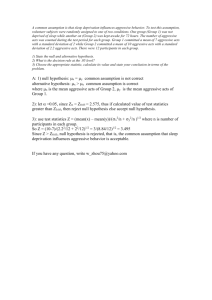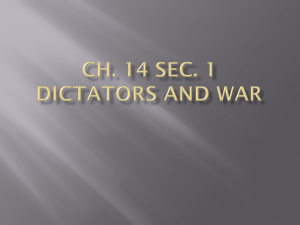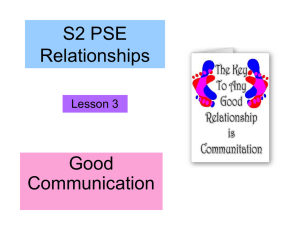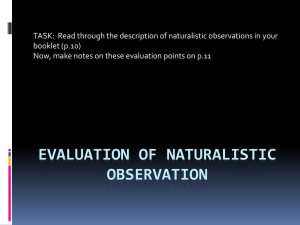the art of effective communication
advertisement
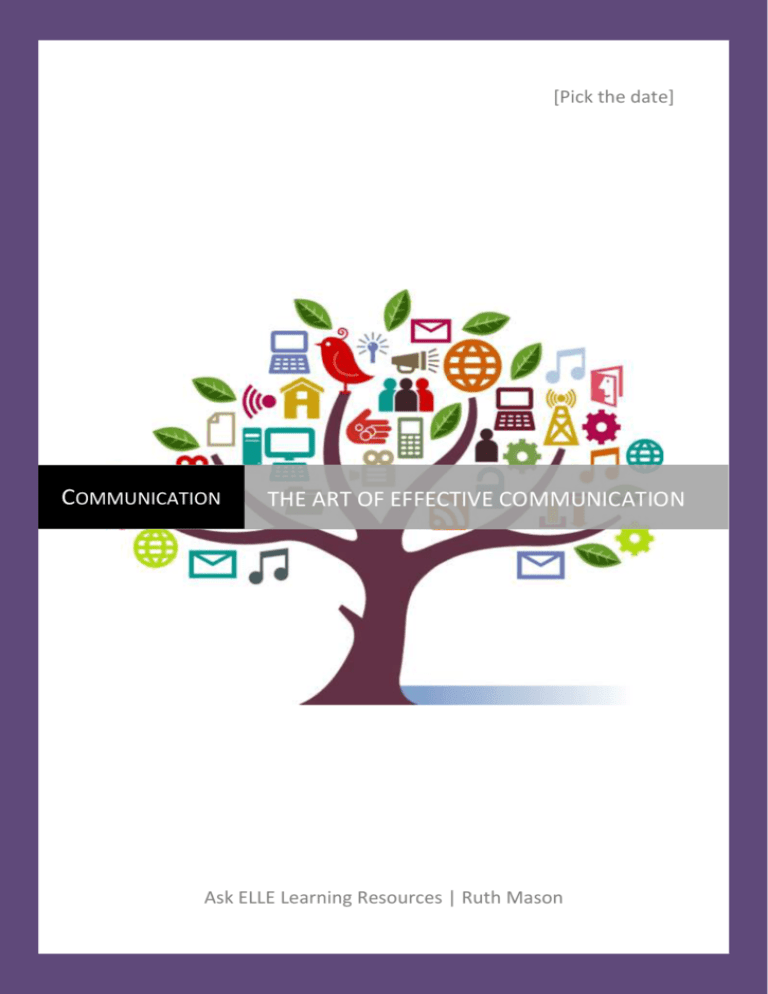
[Pick the date] COMMUNICATION THE ART OF EFFECTIVE COMMUNICATION Ask ELLE Learning Resources | Ruth Mason Document1 SMD/Jan 11 Welcome This workbook has been designed to cover the subject area of communication. It is part of a series of workbooks on the subject and this one is designed to cover the art of effective communication. The workbook is easy to use and totally flexible. Used in conjunction with your organisations training, the workbook can give you the knowledge and confidence to support you within your job role. Introduction to communication Good, clear communications are vital in everything we do. Mistakes, arguments, unhappiness and even disasters can be caused when information and instructions are not passed on clearly and correctly. At work, you need to remember that some communications are more important than others. In today’s fast paced ever changing world the art of effective communication is a vital and understanding how we communicate is a vital skill in improving business relationships. Business success depends on relationships and business relationships depend on clear communication. There are four elements to consider when communicating Clear purpose Target audience Attention to message Outcome These four elements will help structure any form of communication activity - whether it is in writing, presentations or face to face. This workbook is going to give a brief overview of the four elements. Page 2 of 13 Contents Welcome .................................................................................................................................... 2 Introduction to communication................................................................................................. 2 The art of effective communication ...................................................................................... 4 Communication styles............................................................................................................ 4 Four elements to communication ............................................................................................. 5 Element 1 – Clear Purpose ..................................................................................................... 5 Element 2 – Understand your target audience ..................................................................... 6 Element 3 – Attention to the message .................................................................................. 6 Element 4 - Outcome ........................................................................................................... 12 Remember ........................................................................................................................... 13 Reflection ................................................................................................................................. 13 Further Learning ...................................................................................................................... 13 Page 3 of 13 The art of effective communication In today’s fast paced ever changing world the art of effective communication is a vital skill in improving business relationships and by understanding how we communicate can lead to improving business relationships and can help your organisation to deliver: Increased productivity Increased profitability Greater customer satisfaction Better staff/management relationships High innovation More effective sales force Communication styles It is your personal communication style that strongly affects other people’s perceptions of you. If you are direct and always insist on calling a spade a spade then those, who are of a similar disposition, will consider you to be dynamic and forward thinking while those with a less direct style may consider you to be arrogant and rude. This means there will be an element of distrust as soon as you meet. They may accede to your requests but begrudgingly and are unlikely to exceed your expectations. If your communication style is more indirect, you ask rather than tell and you don’t like to rock the boat than those who are of a similar ilk will find you approachable and friendly. However, those with a more direct approach will find you an easy touch and possibly ineffectual. You may find it difficult to persuade or influence such people. Neither communication style is bad, providing you know with whom to be direct or indirect. This is not that much of problem when you are dealing with the same people on a regular basis but what about the first time you meet someone or the cold call or the guest suddenly thrust upon you. Those who prefer the ‘I didn’t get where I am today pussyfooting around the subjects’ as portrayed by Sir John in ‘the rise and fall of Reginald Perrin’ will find an indirect approach weak and indecisive while those whose style is more acceding than demanding will prefer to be asked rather than be told. What is your communication style? Page 4 of 13 Four elements to communication Business success depends on relationships and business relationships depend on clear communication. There are four elements to consider when communicating Clear purpose Target audience Attention to message Outcome These four elements will help structure any form of communication activity - whether it is in writing, presentations or face to face. This workbook is going to give a brief overview of the four elements. Element 1 – Clear Purpose You need to establish a purpose for your communication. Your objectives need to be realistic and your goals need to be defined. To get another person’s agreement you need to reduce vagueness and ambiguity. Effective objectives must be positive. Focus on what you want to do rather than what you don’t want to do. Build a strategy. (Tactics – short term Strategy – long term) If it is a long term project choose the number one objective – the super objective – then decide on less critical ones that help build the strategic objective – the sub – objectives. For example if reducing the amount of waste paper being thrown away is your super objective then a sub objective could be to stop printing out e-mail messages. In the art of effective communication, selecting a super objective for an entire document, presentation or meeting will make it easier to achieve your goal. One way to do this is to express objectives as verbs. This makes the message both powerful and positive. For example, rather than ‘to explain’ try ‘to announce’, to ‘introduce’ or even ‘to reveal’ Choosing the right verb for the occasion is the secret to creating a focussed and powerful plan. The best verbs are physical ones, the ‘doing’ ones. What dynamic verbs can you think of? Page 5 of 13 Element 2 – Understand your target audience Ask yourself six key questions Who is the target audience and what do you want them to feel? What are their needs and expectations? What is their level of knowledge of the topic and terminology? What do you want the audience to understand? Which is the most appropriate method to achieve action What are the points of resistance or negative perceptions? To answer these questions will provide a tactical ‘to do list’ for example If your reaction to ‘what I want them to feel’ is ‘excited’ or ‘with you all the way’ then you may consider asking open ended questions in order to establish rapport and involvement. Taking into account your six key questions will help you meet your target audience needs. Element 3 – Attention to the message The third element in the art of effective communication is to develop the required skills in order to achieve the stated objectives. This is the big part of effective communication! It’s a fact - most people are not born successful communicators; they have to develop the key skills. Only a small percentage of how we are interpreted is obtained from purely verbal communication. The most persuasive form of communication is via non verbal messages these include: Attitude and behaviour Your appearance and clothing Body language – gestures and movements Speech – speed and pitch Eye contact/movement Status symbols and objects We form an impression of each other soon after we meet, usually within the first four minutes. This initial impression is vital. In just four minutes we decide how to perceive each other and what further combination is required. The four minute barrier is scientifically proven. Page 6 of 13 We are going to look at some aspects that can help you get the message across and reach your goal! Research undertaken during the 1980’s and the 1990’s in the UK confirms that only around 50% of oral instructions are received and retained. They also found that information delivered at a lecture drops from over 50% to less than 25% by the end of the presentation. You need to be aware of the following: Questions Use the right type of questions - Who is the one in control – the one asking the question or the one answering it? Closed questions are those that you expect to get either a “yes” or a “no” and as such are useful for controlling/minimising dialogue Open ended questions start with Who, What, Why, Where, When and How. Care needs to be taken when using ‘Why’ as this can be perceived as interrogative and therefore aggressive. Try ‘What are the reasons for’……. rather than ‘Why’ The temptation of not getting all the information needed from one open ended question can be to move on to another ‘door opener’ question on another topic. The efficient communicator ensures he or she has all the information needed on the original topic by asking probing questions Probing questions are used to extract more specific information, thereby reducing the risk of making assumptions. Example. ‘What other changes did you have in mind?’ ‘What was it about the proposal you particularly disliked?’ Try to avoid multiple questioning, for example asking two questions at once. This can be confusing and the only answer you are likely to receive is to the second question. Some people tend to jump in with the second question because they are uncomfortable with the silence that follows the first while the other person is thinking of their answer. Multiple questioning can be overpowering for some people and as such can be perceived as aggressive behaviour. For effective communication, the speaker’s ‘Lyrics’ and ‘Music’ need to demonstrate that they are an assertive person rather than aggressive or passive. Here is a list of words/phrases that can be considered as passive/aggressive with a suggested assertive alternative Page 7 of 13 Best to avoid Why Suggested alternative I can’t/shouldn’t Passive language – recipients are more interested in what you can do rather than what you can’t What I can do is ….. OK Can be perceived by some as relaxed language and may not be appropriate for the organisation in which you work or the situation I hear what you say Is that OK As above with the addition that you are asking the other person a question in adapted child mode and this is passive behaviour Is there anything else? Why haven’t you A question starting with this can be perceived as being critical or judgemental and as such is aggressive behaviour Have you considered ….? You can’t/You shouldn’t No one likes being told what they can’t/shouldn’t do. It is critical parent language and as such is aggressive What you can do is ….. You’ll have to Again this is instructional critical parent language and again demonstrates aggressive behaviour You’ll need to ….. What about ….? When making your suggestions people like to feel that they are being led so that they feel that have to control to make their own mind up rather than pushed into a situation. May I suggest ….? Page 8 of 13 Push techniques are generally considered aggressive Do you understand what I am saying/Is that clear? The onus of understanding here is on the recipient and suggests that if they don’t understand then it is their fault not that of the communicator Have I explained myself clearly? It’s company policy to No one is interested in company policy and demonstrates that you have either your interest or those of the company you work for at heart At X we believe But Whenever you suffix anything with this you either dismiss anything you said before it and/or the recipient will immediately be on the defensive/attack for bad news causing a breakdown in communication However Unfortunately Again how often does good news follow this word? Just avoid saying it Obviously This is often used as a gap filler and can be perceived as being condescending and therefore aggressive Again just avoid it Bear with me This can prompt an internal question from the recipient ‘Why should I, are you not up to the job?’ It is passive language One moment please while I check that Page 9 of 13 And Use your voice One of the most effective ways of improving your voice is to bring it to your attention by listening to it on a tape, but consider the following: Tone Pace Volume Emphasis Pause Clarity Monotone can sound boring; therefore people are less likely to listen. I can also make the subject matter sound boring and uninteresting. A harsh tone can sound aggressive. Use tone to convey interest, enthusiasm, energy and warmth. Too slow can be annoying. Too fast can be aggressive. Pace can be used to slow down a fast speaker through ‘pacing’. Too loud can be aggressive, too soft can be submissive. Again a moderate volume can be used to calm a loud speaker through ‘pacing’. Useful in helping the receiver get the full message when used on key words. However, it can sound domineering and aggressive when used inappropriately This is useful for breaking information into bite size chunks. When used inappropriately it is used as a controlling method to force dialogue from the other party and can be perceived as aggressive. It can also be perceived as a sign of weakness from a submissive person as their pauses allow interruptions Mumbled words can be a sign of nervousness and submissive behaviour. Going over the top on clarity can sound condescending and patronising. Body Language Body language is the most important method of communicating with others. It is also said to be the language that we all speak but few understand. Many of the signals we send out are communicated to the surrounding world without us consciously realising it. There are around one million body language signals including: Movement and posture Facial expressions Eye contact Handshakes Distance from others Sitting position Words may lie but body language seldom does. Using body language involves four stages: Understanding what you are looking for Read people better Recognise it in yourself Learn how to control it Page 10 of 13 Body language can tell us if people are: Bored Impatient Not telling the truth Sympathetic Agreeable Nervous Tired Angry or worried Insecure Truthful Give examples of how you can tell someone is bored, angry and nervous In learning what to look for it is important to consider CLUSTERS. In other words single gestures taken in isolation cannot be taken to be an accurate indication (they may simply be scratching the back of their neck because it itches) It's a fact - If a person' thoughts and words agree they will tend to transmit a clear signal. But remember while you are reading the other person's body language they are reading yours! Actions speak louder than words The other person will be reading you Judge by posture, facial expression or gestures Gesture should be seen in clusters Don’t make hasty judgements Active Listening There is a world of difference between listening and waiting for your turn to talk. The skill of active listening is about not only hearing the words but to understand the meaning and emotions behind them. Active listening involves four main areas Observation. Non verbal communication. Body language, facial expression and gestures. Reflecting information. Paraphrasing or summarising what has been said to confirm you have understood what has been said. Page 11 of 13 Reflecting feelings. Testing out your perception (later) of how the person feels about what they are describing. Supporting. Demonstrating through facial expression, eye contact and gestures that you are actively listening and are still interested. Often listening is done in a half hearted fashion because the listener is preparing a response waiting for their turn to talk. Real influence can only occur in an atmosphere of trust and acceptance. Active listening is a key element to developing this environment as the speaker feels understood and has the opportunity to express their thoughts more clearly and concisely. Element 4 - Outcome The final stage is getting your audience to do something in accordance with your objectives. Choosing direct command words such as 'do it now' 'call me straight away' 'send me an email now' negates any complacency but the more subtle approach can work equally as well where appropriate. Your communication can end with a combination of urgency and optimism. Example; set a challenge, 'which department will be the first to eliminate all waste paper?' ‘let's look at how we can increase productivity by just 2% next month', 'can we agree to read the Chairman's report before tomorrow morning?' There is a long held theory that we are all driven by the right hand / left hand brain theory. This a scientifically proven study that indicates most people have a bias towards one side of the brain. The right side deals with creativity and pictures while the left hand side considers logic and analytical functions such as numbers and words. A good communicator, by understanding how the brain works, ensures his or her messages appeal to both sides of the brain. Those with a left hand bias will soon tire of 'painting pictures' and start demanding more reasoned argument, possibly with facts and figures while those with a right hand bias will not appreciate 'cold facts' being presented. The human brain thrives on a mix of facts and fantasy; a good communicator weaves all the key senses into the message. Facts and Fiction - use anecdotes to illustrate your point Paint the brightest picture - use metaphors or show them something relevant to the message (a pie chart showing the savings made through recycling waste paper) Try using rhyme for enabling people to remember Page 12 of 13 Remember Here is some food for thought when thinking about effective communication When passing on information we regularly distort or omit facts When receiving information we often filter unwelcome news and remember only the positive things People switch off if given too much information We restrict the sharing of information by self-selection Despite the internet, distance is still a barrier. Near-by people are kept more informed than distant colleagues People respond best to urgent communications The fewer links the better the communication Reflection Think of a time you have communicated with colleagues, how would you have taken what you have learnt from this workbook to make the communication better? Further Learning Visit Ask ELLE for learning against all aspects of communication Page 13 of 13


